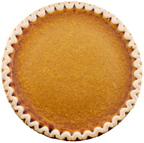You can spend hundreds of dollars on neat-looking gadgets that promise to assist in the production of the perfect holiday pie. There are stenciled slip-proof pastry mats and zippered plastic bags that help bakers roll out right-sized round crusts. There are pretty porcelain bird vents that keep pie middles lofty and huge cookie cutter-like contraptions that instantly decorate them.
There are pie plates that help you pristinely crimp the edges, a torturous-looking tool that has rotating spikes for docking crusts, non-stick donut-shaped metal discs that guard the oven floor from pie juice spillage, truncated metal spatulas that get baked into the pie so removing the first slice is a piece of cake, and a dam-like device that keeps the juices from flowing out of place once the pie is opened.
But professional pie makers — while curiously examining all types of gadgets for this article and sometimes deeming them worth their purchase price — stick to a much smaller sample of kitchen tools to get the job done.
Two Fat Cats Bakery owner Stacy Begin argued there are no quick and dirty substitutions for an even rolling pin, a cool, well-floured surface, a sturdy pastry-cutting tool with a slightly decorative edge and a metal pie tin when baking a pie.
But there are home kitchen conditions that warrant some special-purpose tools. An unpredictable oven, for one, says Begin.
“Pie crust protectors can help home cooks make sure the edges of the pies don’t burn before the middle is fully cooked,” she said.
Stella Parks, a Kentucky-based pastry chef and blogger at bravetart.com, said a crust shield is the only pie-specific gadget she’s used, especially when she’s cooking pies in her parents’ oven at Thanksgiving. Parks has used older metal ones for the job, but thinks the new silicon-based ones are useful because they don’t conduct heat to the crust. “On the other hand, you don’t want a floppy one because it’s tricky to stick in the oven real quick. But if it were rigid, I’d be all over it,” said Parks.
Joanne Chang, pastry chef and own of Flour Bakery and Cafe (flourbakery.com/team/joanne-chang) in Boston, eschews pricy ceramic or metal pie weights for blind baking crusts (a partially- or fully-baked crust) for holiday staples like pecan and pumpkin pie.
“We use uncooked (dried) beans. They are the best,” said Chang of her blind baking crust method.
Fat Cat Bakery pie maker Evan Daigle suggests that an easy way to keep these dried beans from making divots in the dough and allowing for easy removal after baking is to line the raw crust with a coffee filter. He adds that the beans can be saved and reused but should always be cool before they are placed into the unbaked pie shells.
All of these professional bakers agreed, though, that the kitchen tool that weighs most heavily in the perfect pie is, of course, the dessert fork.
Christine Burns Rudalevige is a freelance writer.
Send questions/comments to the editors.






Success. Please wait for the page to reload. If the page does not reload within 5 seconds, please refresh the page.
Enter your email and password to access comments.
Hi, to comment on stories you must . This profile is in addition to your subscription and website login.
Already have a commenting profile? .
Invalid username/password.
Please check your email to confirm and complete your registration.
Only subscribers are eligible to post comments. Please subscribe or login first for digital access. Here’s why.
Use the form below to reset your password. When you've submitted your account email, we will send an email with a reset code.